Authentic Ojja Eggs Cooked Tunisian Style
38 min read Discover the spicy, rustic charm of Tunisian ojja—eggs simmered in a harissa-tomato sauce with peppers and optional merguez—plus tips, variations, and cultural roots for an authentic experience. October 03, 2025 21:07
The first time I smelled ojja, it wasn’t in a restaurant with linen napkins or on a glossy cooking show. It was in a blue-trimmed courtyard in Sidi Bou Saïd, where a neighbor’s skillet sent up curling threads of perfume: garlic blooming in olive oil, tomatoes surrendering their sweetness, harissa melting into a brick-red sheen. The sound—gentle plops of eggs hitting sauce, the conspiratorial hiss as a lid got clapped on—gave way to an aroma that grabbed the ribs and asked, firmly, that you bring bread. When she lifted the lid, the eggs were lacquered with steam, their yolks swollen and golden, the sauce flecked with caraway, tap-tapping with heat. This is the Tunisian morning I return to whenever I make ojja.
What Makes Ojja Unequivocally Tunisian
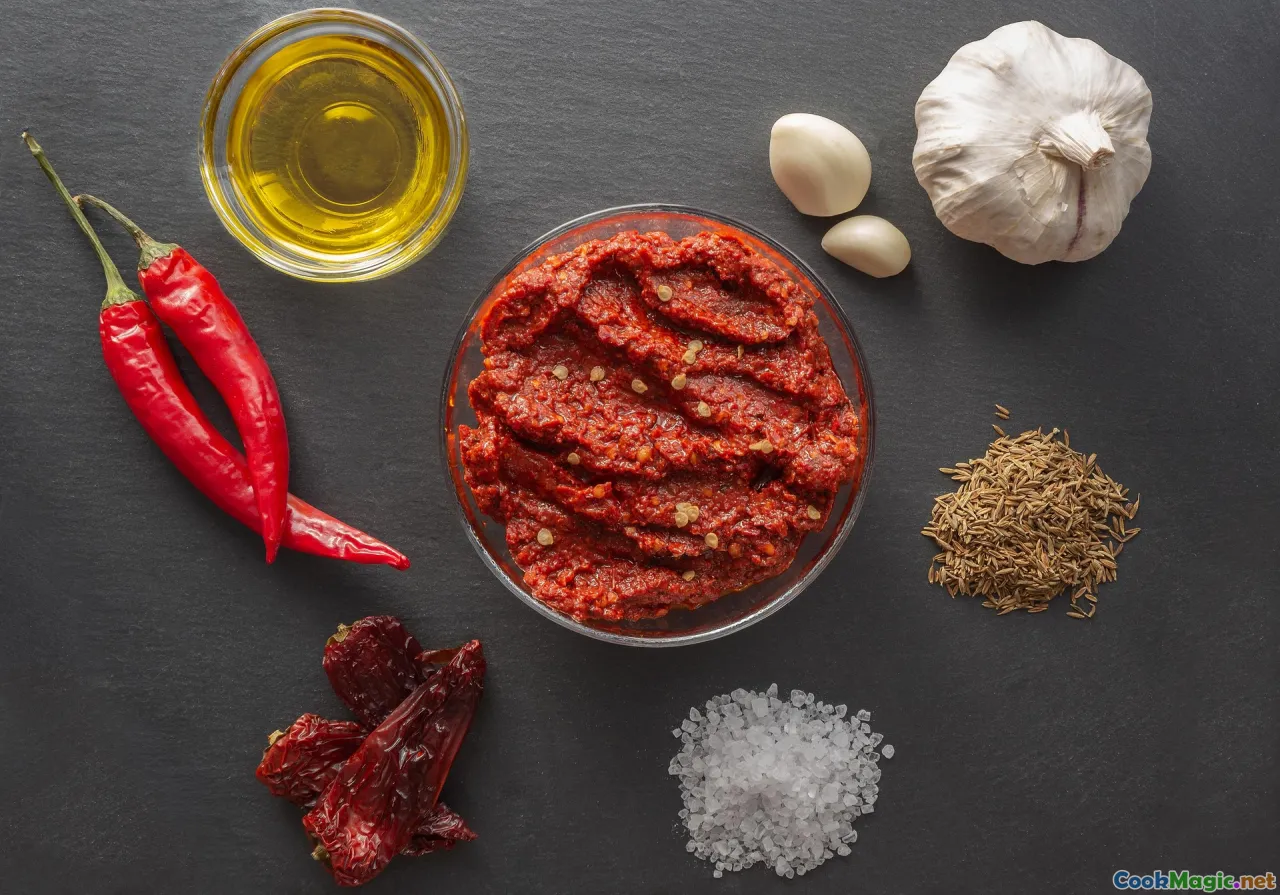
Ojja is the Tunisian way of treating eggs like honored guests. Yes, it shares a family resemblance with shakshuka—the Maghrebi tomato-and-egg braise that’s conquered brunch menus around the world—but the Tunisian soul of ojja lies in its spice vocabulary, its pace, and its lived-in practicality.
At its heart is harissa, the national paste that tastes like the sun had a conversation with the sea and a field of chilies took notes. Good Tunisian harissa is not just heat; it’s a layered cord of flavor: sun-ripened baklouti peppers, coriander and caraway (karwiya), a mild garlic sweetness, and the low purr of olive oil. In ojja, harissa isn’t a garnish—it’s architecture. And then there’s tabil, a Tunisian blend built around coriander seed and caraway, traditionally pounded with dried chilies and garlic. Sprinkle it in, and the sauce gains a compass—it points unambiguously toward the southern Mediterranean.
Beyond the spices, ojja often invites merguez to the party. The scarlet lamb or beef sausages, slick with harissa and smoke, bring the skillet’s first sizzle. In coastal towns, shrimp slide in instead—the shells briefly kissed in oil to whisper of tide and brine before being slid aside and returned later. Ojja respects Tunisia’s variety: the spice bazaars of Nabeul in Cap Bon, the fishing docks of Sfax, the limestone streets of Kairouan. It tastes of all those places at once.
Texture matters, too. Ojja’s sauce isn’t a stew or a soup; it’s a concentrated bed. Tunisians are generous with tomato paste—often double-concentrated—and don’t apologize for letting it caramelize a shade darker than you’d think prudent. A spoon dragged through should leave a wake before slowly closing; when eggs hit that surface, the whites spread just enough to nest, not to drown. The result is something you can scoop, mop, and share with khobz tabouna—the sesame-topped semolina bread baked in wood-fired clay ovens—or with mlawi, the flaky spiral flatbread that tears into tender cords.
A Morning in the Medina: A Personal Ojja Memory

In the medina of Tunis, where the alleys narrow and widen like an accordion being sung to, mornings sing of bread and spice. I remember one summer morning when I followed the scent of warmed cumin and hot metal to a small snack bar not far from Bab Bhar. The counter wore its years proudly: iron pans stacked, ladles stained sunset-red, a small mountain of green peppers waiting to be stripped and softened.
The cook, a man whose forearms looked like they’d been basted by sun and spice, had two pans going: one for ojja bil merguez, another for a shrimp variation he called qamroun, each started with a spoonful of harissa that bloomed like a red flower in olive oil. He teased the tomato paste in until it colored and sweetened, added chopped tomatoes and garlic that he crushed with salt until it whispered into the oil, and then he did something that told me he’d made this a thousand times—he tipped in a splash of water from a copper kettle and let it come to a decisive simmer. He tasted, frowned, added a pinch of caraway—karwiya—like a musician bringing a trumpet into the mix. When the sauce held together, he cracked eggs from a basket, never looking down for the shell. The whites seized in velvety threads; the yolks sat like moons. He heated and waited by feel, not timer, nudged the pan to settle the sauce around the eggs, then scattered parsley and called for bread.
I remember the first scoop: how the tender sausage bites dissolved into the sauce with a smoky, almost cumin-like hum (a trick of caraway), how the yolk gilded the edges of the bread. There was heat, yes, but also a roundness from the olive oil and tomato. A sip of cool lben, the tangy buttermilk that Tunisians drink with spicy breakfasts, reset the palate. Outside, a moped sputtered past; inside, the pan crackled when the bread brushed it. This is the memory I carry home and unpack whenever I stir tomato paste in a pan for ojja.
Ingredients: The Tunisian Pantry Behind Ojja
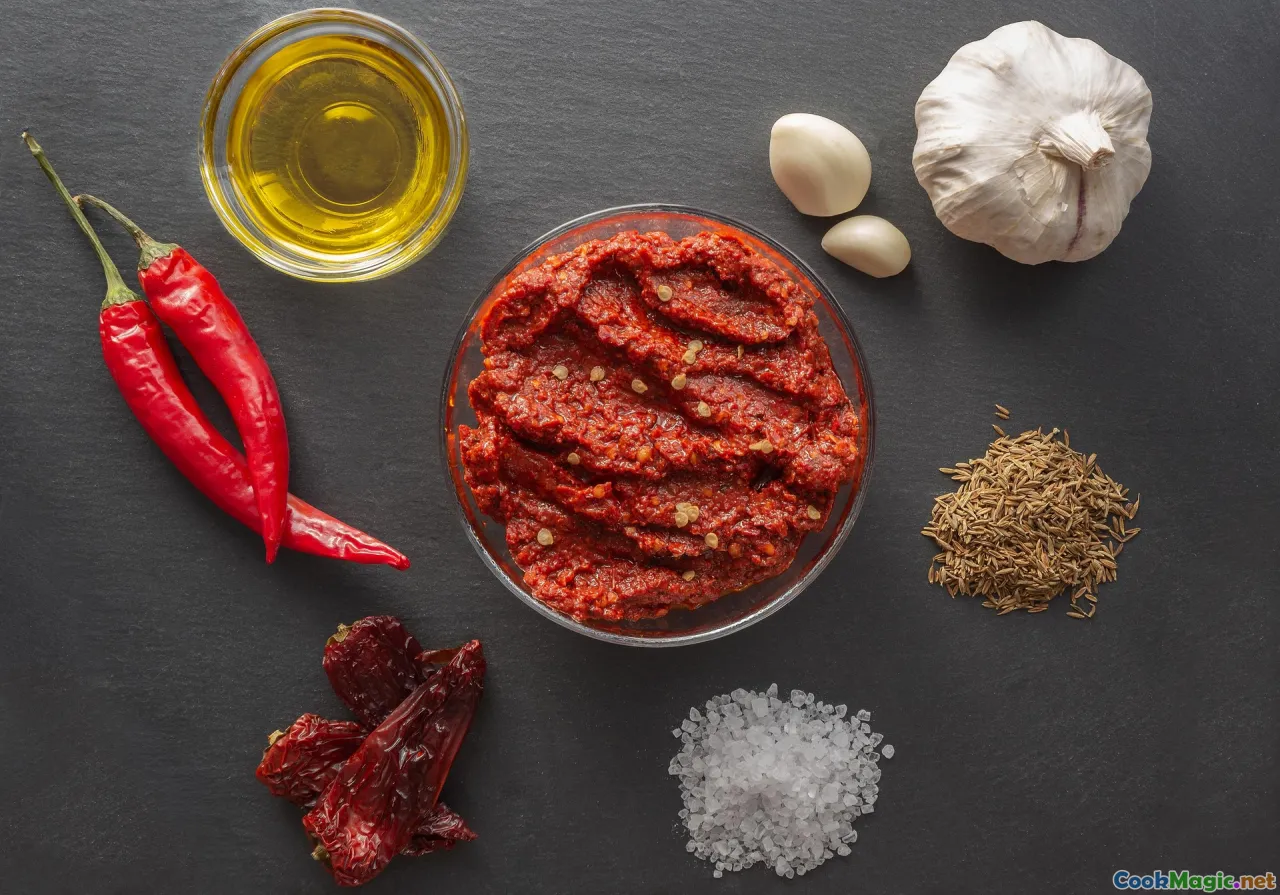
Ojja is a short recipe that leans on intensity. You’ll want ingredients that speak clearly and carry the Tunisian accent.
- Olive oil: Use a robust, fruity oil. In Tunisia, Cap Bon oils often have peppery bass notes. Plan for 2–3 tablespoons (30–45 ml) per pan.
- Harissa: Look for a Tunisian harissa with baklouti peppers. Le Phare du Cap Bon is widely available and reliable; artisanal harissas from Nabeul or Testour can be extraordinary. Start with 1–2 teaspoons (5–10 g) and adjust for heat and salt.
- Tomato paste: Double-concentrated if you can find it. You’ll want 1–2 tablespoons (20–40 g). Some Tunisian grandmothers stir in a little homemade mark (sun-dried tomato) for depth.
- Tomatoes: Ripe plum tomatoes or canned whole peeled. You’ll need 2–3 medium tomatoes, peeled and chopped, or 1 cup (240 g) of canned.
- Garlic: Tunisian garlic is smaller and powerful; 3–4 cloves, minced to a paste with a pinch of salt.
- Peppers: Green bell pepper or a waxy green frying pepper for a bitter-sweet backbone; a red bell or ripe baklouti for sweetness and color; optional fresh chili if you want extra fire.
- Merguez: For the classic ojja bil merguez. Plan 200–250 g (7–9 oz). If you can find Tunisian-style merguez (lamb-beef, harissa-heavy), say yes.
- Eggs: The star. Four to six, depending on pan and crowd. Fresher is better for compact whites. Room temperature eggs set more evenly.
- Spices: Ground caraway (karwiya) and ground coriander (tabil), 1/2–1 teaspoon each. A pinch of cumin is optional but not traditional in all households.
- Salt and black pepper: Taste and season generously; harissa brings some salt.
- Fresh herbs: Flat-leaf parsley and/or cilantro. Some cooks add tender celery leaves.
- Optional: A few preserved lemon slivers (msayer) for a coastal wink; a squeeze of lemon at the end; a handful of peeled shrimp for ojja qamroun.
Beyond the lay of ingredients, Tunisia’s pantry offers attitude. The harissa should not be timid; the tomato paste should see a little fire; the oil should carry the spices and sauce together like a steady tide. Ojja is not timid food. It invites you to lean forward.
Technique: From Sizzle to Set

Cooking ojja is about managing heat, concentration, and that elusive line between set and still-lustrous eggs. Think of it as three acts: sizzle, simmer, set.
-
Sizzle: If you’re using merguez, start by browning it in olive oil over medium-high heat in a heavy pan (cast iron or a thick aluminum pan, 24–28 cm wide). You want color and rendered fat, about 5–7 minutes. Reserve the sausage and leave the fat in the pan. If making a shrimp ojja, quickly sear shrimp just until they blush and set aside.
-
Bloom: Lower heat to medium. Add a fistful of chopped peppers and sauté until they soften and blister at the edges, 6–8 minutes. Stir in the garlic paste and sauté until the room smells like you’ve woken something up—30 seconds. Make a small well in the pan and drop in the harissa; let it sizzle and stain the oil. Add the tomato paste and cook it out, stirring until it shades deeper, 1–2 minutes. This step separates okay ojja from extraordinary ojja.
-
Simmer: Stir in chopped tomatoes and a splash of water—start with 60 ml (1/4 cup)—just enough to give the sauce room to move. Season with salt, caraway, coriander, and black pepper. Let the sauce simmer until glossy, 8–12 minutes. It should thicken so that dragging a spoon across leaves a slow-closing furrow. Taste and adjust seasoning; a pinch more caraway might lift the perfume.
-
Set: Return the merguez (or shrimp) and nestle them into the sauce. Lower heat to medium-low. Use your spatula to create shallow wells. Crack eggs gently into the wells. Let the whites set from the edges inward. You can cover the pan lightly for 1–2 minutes to steam the tops if you want a tender veil over the yolks, but don’t lose sight of them—the line between silky yolk and chalky center is thin. Aim for 4–6 minutes total, depending on your pan and eggs. Jiggle the pan: when the whites are opaque and the yolks tremble like custard, you’re there.
-
Finish: Scatter herbs. Off the heat, a thumbprint of olive oil and, if you like, a squeeze of lemon wakes everything up. Serve straight from the pan with bread within reach.
What you’re seeking is a balance between concentrated, almost jammy tomatoes and the living softness of eggs. The spoon should meet a little resistance, then give way; the bread should pick up ribbons of sauce without dripping. This is ojja’s signature texture.
Recipe: Ojja bil Merguez (Authentic Tunisian Sausage and Eggs)

Serves 2–3 generously
Ingredients:
- 2 tablespoons (30 ml) olive oil
- 250 g (9 oz) merguez sausages, cut into bite-size pieces
- 1 medium green pepper, diced
- 1/2 red bell pepper, diced (or 1 ripe baklouti pepper)
- 3–4 garlic cloves, minced to a paste with 1/2 teaspoon salt
- 2 teaspoons (10 g) harissa, or to taste
- 2 tablespoons (30 g) double-concentrated tomato paste
- 2 medium ripe tomatoes, peeled and chopped (or 1 cup/240 g canned, crushed by hand)
- 1/2 teaspoon ground caraway (karwiya), plus more to taste
- 1/2 teaspoon ground coriander (tabil)
- Black pepper, to taste
- 4–6 eggs
- Handful of chopped parsley and/or cilantro
- Olive oil and lemon wedge, for finishing
Method:
-
Brown the merguez: Heat olive oil over medium-high in a 24–28 cm skillet. Add merguez and brown well, stirring, 5–7 minutes. Scoop out and reserve; leave the rendered fat.
-
Build the base: Lower heat to medium. Add green and red peppers and sauté until softened and charred in spots, 6–8 minutes. Stir in garlic paste; cook 30 seconds.
-
Bloom the pastes: Push vegetables aside. Drop in harissa and tomato paste. Cook, stirring, until the pastes darken slightly and smell sweet and toasty, 1–2 minutes.
-
Sauce: Add chopped tomatoes and 1/4 cup (60 ml) water. Season with caraway, coriander, and black pepper. Simmer on medium until the sauce thickens and glosses, 8–12 minutes. Taste; adjust salt and spices. You want a robust, almost spoon-standing sauce.
-
Return the merguez; bring back to a simmer.
-
Eggs: Lower heat to medium-low. Make wells; crack in eggs. Cook uncovered until whites turn opaque but yolks are still soft, 4–6 minutes. Cover the last minute if you want a light film over the yolks.
-
Finish: Scatter herbs. Drizzle a thread of olive oil and squeeze a little lemon if desired. Bring the pan to the table and serve with khobz tabouna or mlawi.
Notes:
- Spice balance: Tunisian ojja leans caraway-forward. Start modestly, then tip in an extra pinch if the sauce smells good but tastes shy.
- Heat control: If your harissa is especially fiery, temper with a splash more tomato or a spoon of olive oil at the end.
- Egg set: For firmer yolks, cover and let carryover heat finish for 2 minutes off the flame.
Variation: Ojja Qamroun (Shrimp Ojja from the Coast)
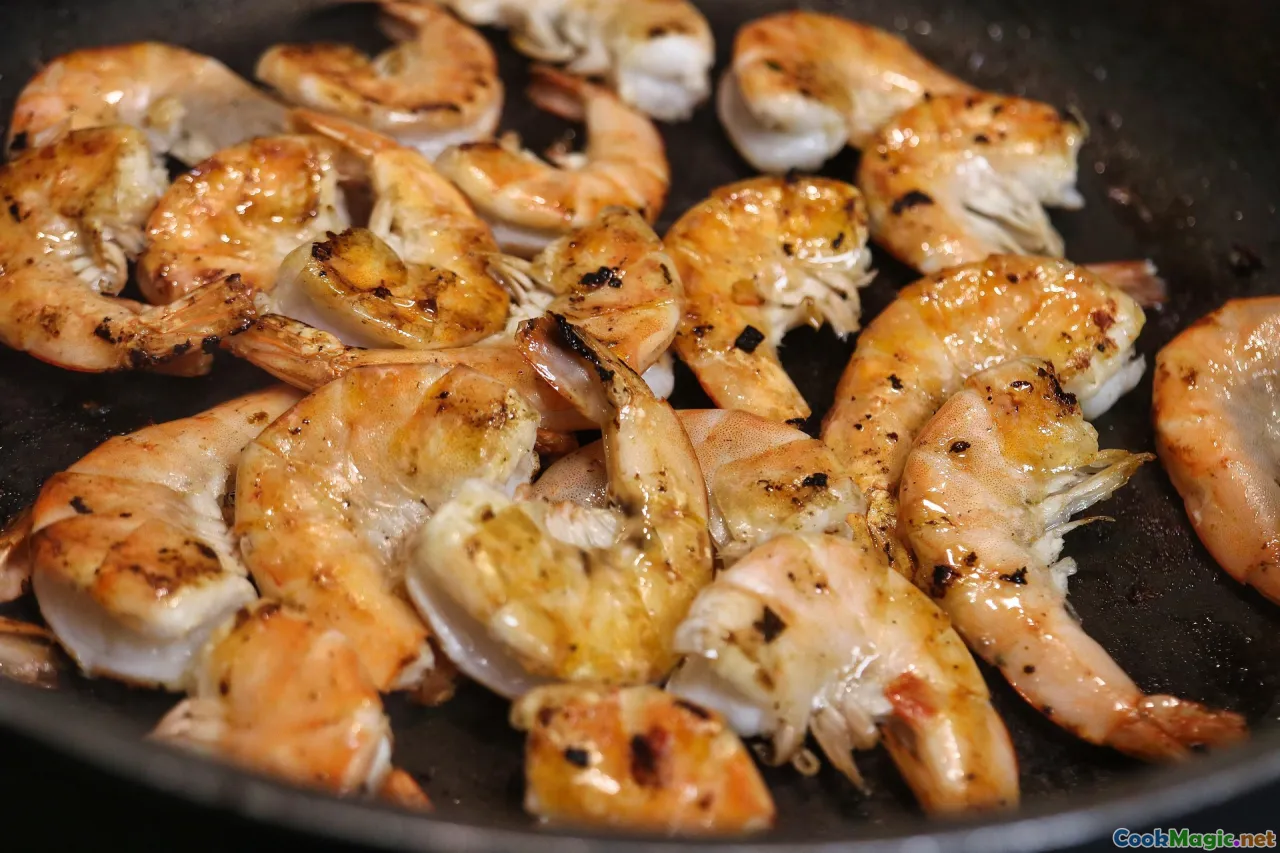
In coastal cities like Sfax and Mahdia, shrimp ojja is the skillet that takes you straight to the port—briny steam, pink curls, and a sauce that skews slightly lighter so the sea can speak.
Serves 2–3
- 2 tablespoons (30 ml) olive oil
- 300 g (10–11 oz) raw shrimp, peeled (keep shells for a quick oil if you have time)
- 1 small green pepper, diced
- 3 garlic cloves, minced to a paste with salt
- 1–2 teaspoons (5–10 g) harissa
- 1 tablespoon (15 g) tomato paste
- 1 cup (240 g) chopped ripe tomatoes
- 1/2 teaspoon ground caraway (karwiya)
- 1/2 teaspoon ground coriander
- 4–5 eggs
- Lemon wedges; chopped parsley and celery leaves
Method:
-
Optional shrimp shell oil: Briefly sizzle the shells in the oil over medium heat until fragrant, 2–3 minutes; strain, return oil to pan.
-
Sear shrimp just until they blush; remove and reserve. Season lightly.
-
Sauté green pepper until softened; add garlic for 30 seconds.
-
Bloom harissa and tomato paste until aromatic, 1–2 minutes.
-
Add tomatoes, caraway, and coriander. Simmer 6–10 minutes until slightly thick but not as reduced as merguez ojja.
-
Return shrimp to the pan to warm through.
-
Create wells and crack eggs. Cook until the whites are set and yolks quiver. Herbs and lemon finish. Serve hot.
The shrimp’s sweetness plays against the harissa’s heat, and a squeeze of lemon sets the edges sparkling. In Sfax, I once watched a cook add a whisper of preserved lemon rind—msayer—finely chopped. It was not enough to dominate, only enough to underline the shrimp’s brine.
Variation: Ojja bel Felfel (Green Pepper Ojja for the Market Morning)
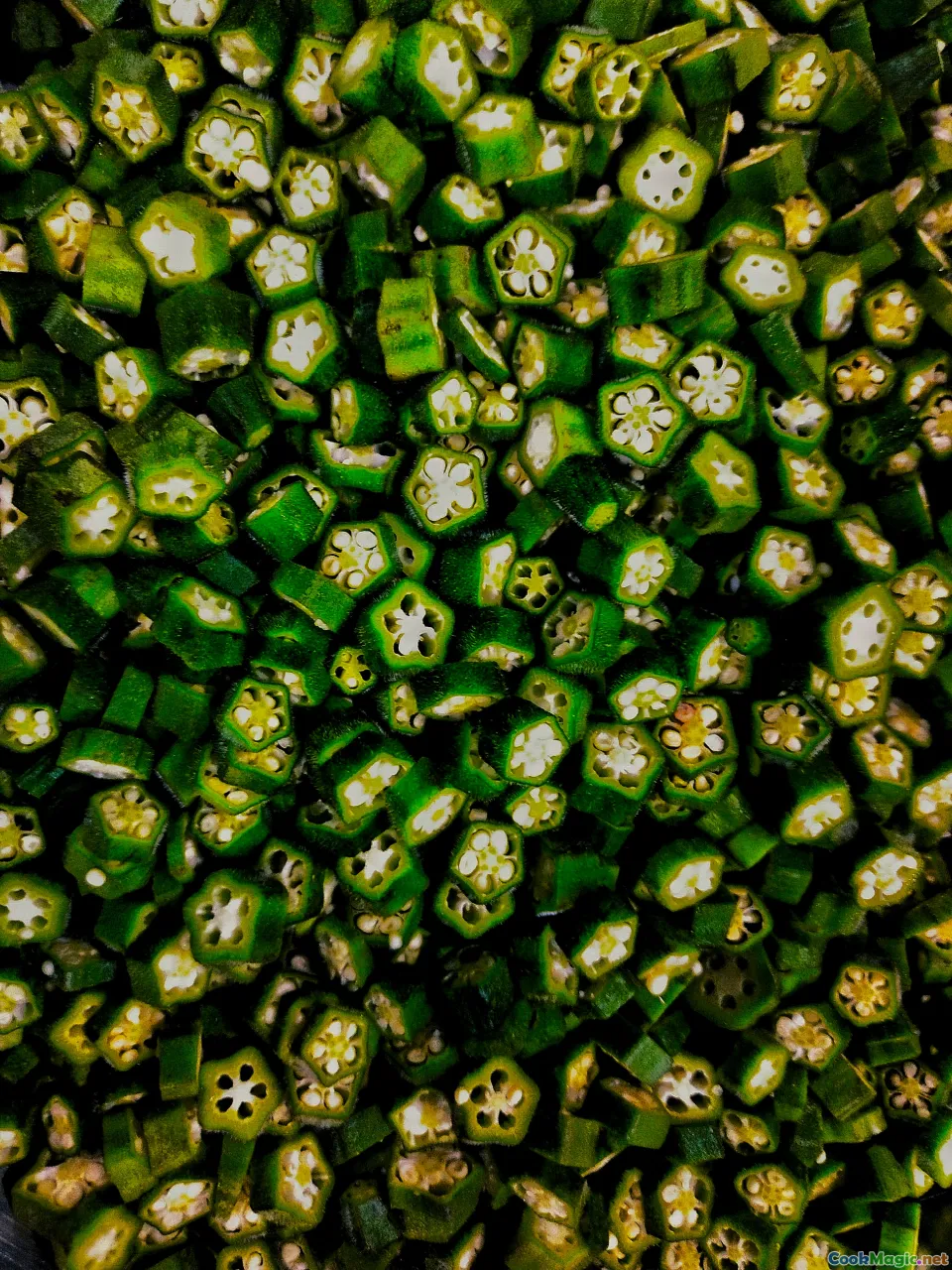
Not all ojja needs meat or seafood. One of the most comforting versions focuses on peppers—softened, slightly bitter, unbelievably good with eggs and a little cheese scraped on top if you like to bend tradition.
- 3 tablespoons (45 ml) olive oil
- 3–4 green peppers (bell or frying type), sliced into strips
- 1 small onion, thinly sliced (optional, not universally used)
- 3 garlic cloves, minced
- 1–2 teaspoons (5–10 g) harissa
- 1–2 tablespoons (15–30 g) tomato paste
- 1 cup (240 g) chopped tomato
- 1/2 teaspoon caraway; 1/2 teaspoon coriander
- 4–6 eggs
- Handful parsley; optional crumble of brined fresh cheese
Sauté peppers (and onion, if using) slowly in olive oil until sweet and wilted, 10–12 minutes. Build the sauce as above, with harissa, tomato paste, and tomatoes. Season assertively with caraway and coriander. Crack in eggs and cook to your preferred set. Sometimes I add, off the heat, a few dots of a soft, slightly salty fresh cheese—not strictly canonical, but persuasive. With mlawi, this is a market-morning breakfast that carries you until late afternoon.
Shakshuka vs. Ojja: Similar Heat, Different Heart

The words swirl: shakshuka, chakchouka, ojja. All related, all bearing tomatoes and eggs, all shaped by North Africa. But ojja stands distinctly Tunisian in three practical ways.
- Spice profile: Shakshuka often leans toward cumin and sweet paprika, with a bright pepper-garlic profile. Ojja speaks caraway and coriander—tabil and karwiya—alongside harissa. That change alone shifts the aroma from earthy to perfumed.
- Fat and concentration: Tunisian cooks don’t fear olive oil in ojja; it carries flavor, suspends spice, and coaxes tomato paste into caramel. The result is a thicker bed with a glossy sheen, designed to be scooped with bread rather than spooned like stew.
- Garnishes and additions: Merguez, shrimp, and even small cubes of liver (for the bold) show up in ojja. In shakshuka, cheese or herbs might take the headline; in ojja, the proteins and the harissa do.
There’s overlap and familial borrowing across borders, of course; the Maghreb is a region of shared technique and lively interpretation. But sit with ojja and you taste a specific address.
The Science of Flavor in Ojja

Understanding ojja at the molecule level can improve your skillet craft.
- Blooming pastes: Tomato paste and harissa contain sugars, acids, and oils. When you sizzle them briefly in olive oil, you enable Maillard browning and light caramelization, which deepens sweetness and complexity. The oil extracts fat-soluble aromatic compounds (terpenes in coriander, carvone in caraway), dispersing them evenly in the sauce.
- Oil as a conductor: Olive oil doesn’t just lubricate; it forms a micro-emulsion with the tomato’s pectin and the harissa’s capsaicin-laden oil, leading to a sauce that clings to bread. Skimp and you risk a watery, grainy texture; drown and you smother the acidity and lift that keeps ojja lively.
- Egg set: Whites begin to set around 62–65°C (144–149°F), yolks around 65–70°C (149–158°F). Keeping the sauce at a steady simmer rather than a boil helps you land a tender white without chalking the yolk. A brief cover traps steam and sets the tops without overcooking the bottoms.
- Capsaicin and balance: Harissa’s heat rides on capsaicin, which binds to fat receptors. That’s why a thread of olive oil and a sip of lben temper the burn more elegantly than plain water would. A squeeze of lemon brightens the tomato’s malic and citric acids, which in turn sharpen perception of salt and spice.
When a Tunisian cook tells you to “cook the paste,” they’re telling you to unlock stored complexity—like caramelizing onions in a French onion soup. Respect that step, and your ojja moves from good to irresistible.
Bread to Scoop and Share: What to Serve with Ojja
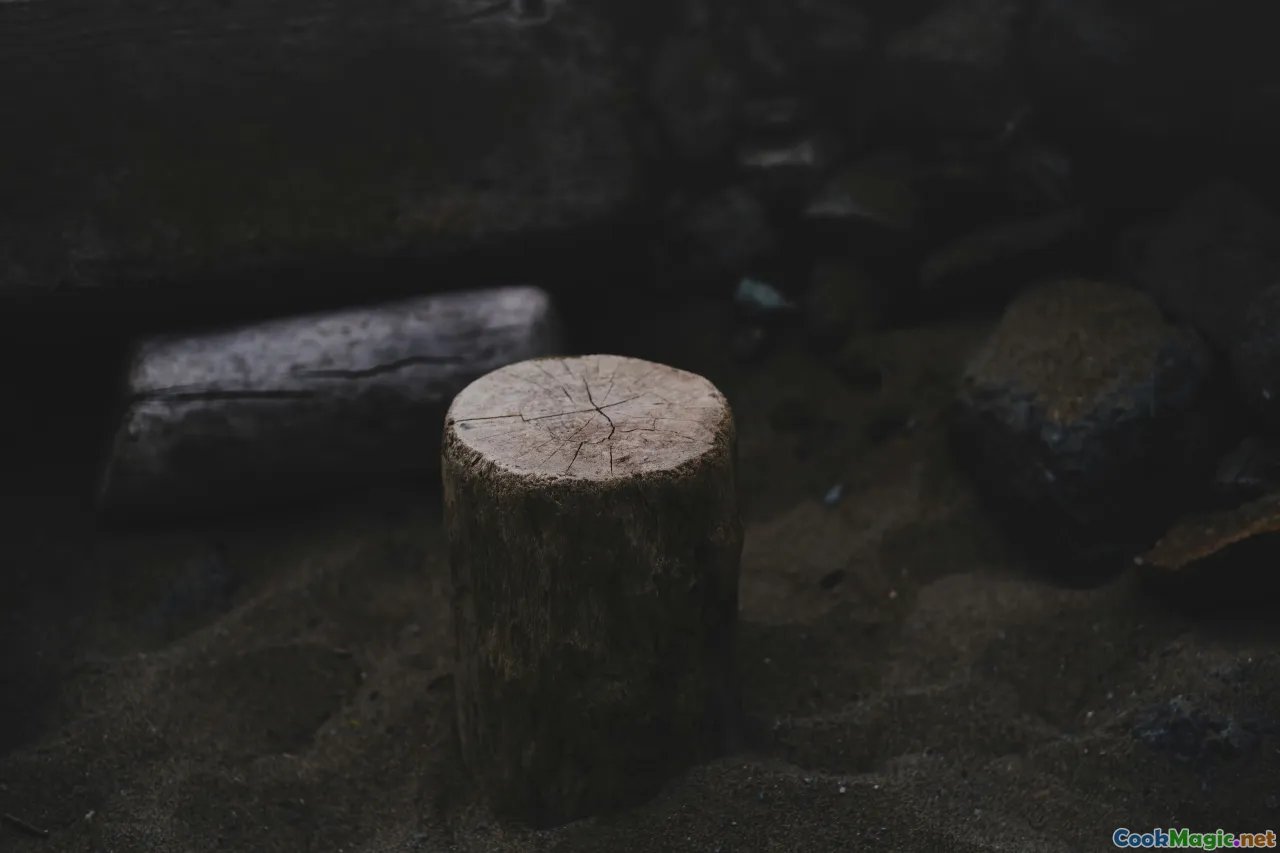
Ojja without bread is a story missing its final chapter. Tunisia’s breads are built for this.
- Khobz tabouna: Semolina-based, sesame-freckled, and baked in clay ovens, tabouna has a crust that sings when torn and an interior that springs back like memory foam. Its toastiness pairs beautifully with the tomato’s sweetness and the harissa’s heat.
- Mlawi: A laminated flatbread, spiraled and pan-cooked, with layers that tear in soft ribbons. Mlawi is almost indecent with ojja; the oil in its folds picks up the sauce and makes each bite luxuriant.
- Khobz el tounsi: Everyday Tunisian bread, sometimes enriched with semolina, sometimes not—reliable, sturdy, and perfect for corralling egg and sauce.
To drink, Tunisians often choose lben (buttermilk) or rayeb (set fermented milk) with spicy breakfasts. The tang resets the palate between bites of merguez-laced heat. In the afternoon, mint tea with pine nuts is a beautiful counterpart, though it pulls the dish toward a leisurely lunch.
Sourcing and Substitutions for the Diaspora Cook

If you’re far from Tunis, you can still put a convincing ojja on the table.
- Harissa: Tunisian brands like Le Phare du Cap Bon are widely stocked. Read the label; you want chilies, garlic, coriander, caraway, salt, olive oil. If all you can find is a Moroccan-style harissa heavy on cumin, balance with extra caraway and coriander.
- Merguez: Butchers in French, North African, or Middle Eastern neighborhoods often make lamb-beef merguez with harissa. If not, use a fresh spicy sausage and season the sauce with a bit more harissa. Avoid sweet Italian sausage; fennel muddies the Tunisian profile.
- Peppers: If baklouti is unavailable, use red bell pepper for sweetness and a serrano or Fresno for heat. For green peppers, a standard bell or an Italian frying pepper works.
- Tomato paste: Double-concentrated paste has a deeper tomato hit. If using single-concentrated, cook it longer to drive off water.
- Spices: Seek out whole caraway and coriander seeds. Toast lightly and grind fresh; the perfume is non-negotiable. If you must use pre-ground, increase slightly and adjust to taste.
- Olive oil: A bold extra-virgin complements ojja’s intensity. If yours is very peppery and bitter, balance with a milder oil or a splash of neutral oil.
Don’t be too precious about substitutions; Tunisia herself has adapted ingredients over centuries—from Ottoman peppers to New World tomatoes—yet maintained her identity. If the pan smells right and invites bread, you’re on the path.
Common Mistakes and How to Fix Them
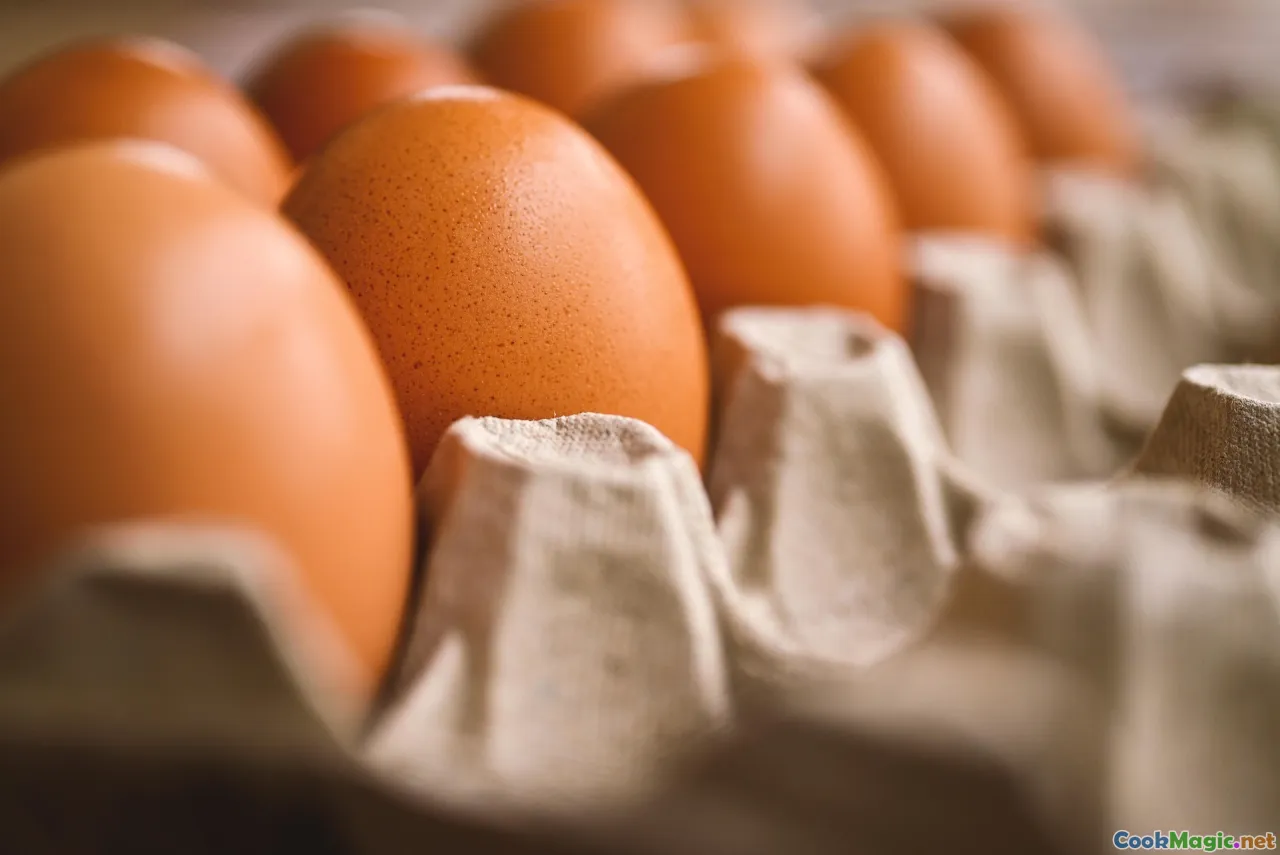
- Watery sauce: You added too much water or didn’t cook the tomatoes down. Remedy: Increase heat and reduce until sauce thickens. Stir in a small spoon of tomato paste and cook it out to restore concentration.
- Harsh, raw-tasting tomato paste: You didn’t cook it long enough. Remedy: Clear a space in the pan and sauté paste and harissa until they darken slightly and smell sweet, then reincorporate.
- Overcooked eggs: The yolks turned chalky before the whites set. Remedy: Lower the heat, and next time create a thicker sauce bed so the whites set faster. Cover briefly at the end to set tops without blasting bottoms.
- Greasy pool: Too much oil not absorbed by sauce. Remedy: Cook paste longer, add tomato to emulsify, or blot a little oil at the edges with bread—someone will volunteer.
- Flat flavor: Not enough spice or acid. Remedy: Add a pinch more caraway and coriander, a squeeze of lemon, or a fresh spoon of harissa. Salt to the edge of pleasant.
From Home Kitchen to Bistro: Presenting Ojja
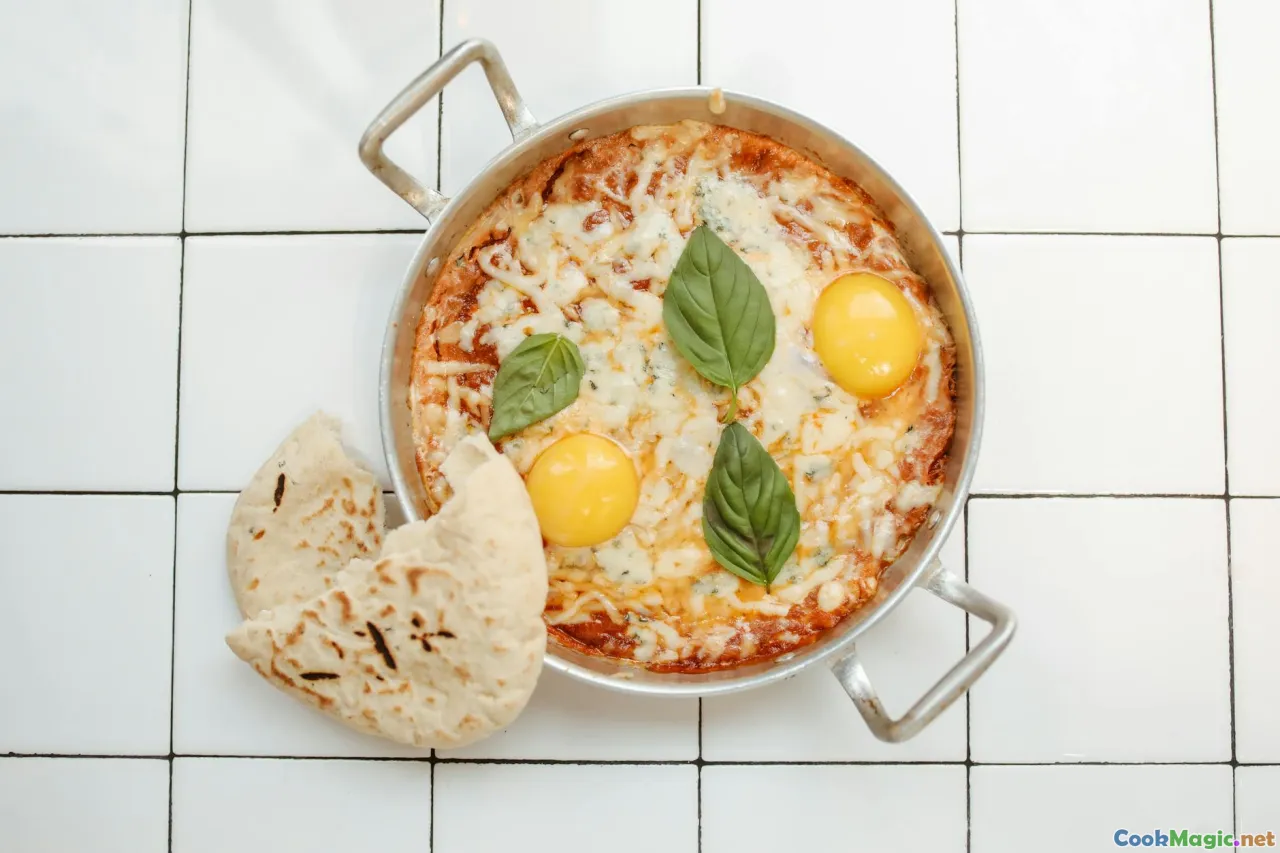
Ojja’s natural stage is the pan: heavy, slightly battered, honest. If you’re serving guests, individual small skillets make for striking presentations and practical egg control. Scatter herbs just before serving; the green against the red-gold is Tunisia’s flag in edible form.
A few plating nudges:
- Brush the rim clean before the eggs go in; neat edges make the yolks look more luminous.
- Keep a pot of warm water ready to loosen any sauce that tightens as you cook multiple pans.
- Offer a trio of breads on a wooden board—tabouna wedges, mlawi squares, and a torn loaf of country bread—and let guests choose their scoop.
- A small dish of extra harissa, thinned with olive oil, lets the heat-seekers tune their plate without overwhelming the base.
In bistros from La Goulette to the center of Tunis, you’ll find ojja served with a small side salad—tomato, cucumber, onion, mint, dressed with lemon and olive oil—to add crunch and coolness. Borrow that habit at home.
Where to Taste Ojja in Tunisia
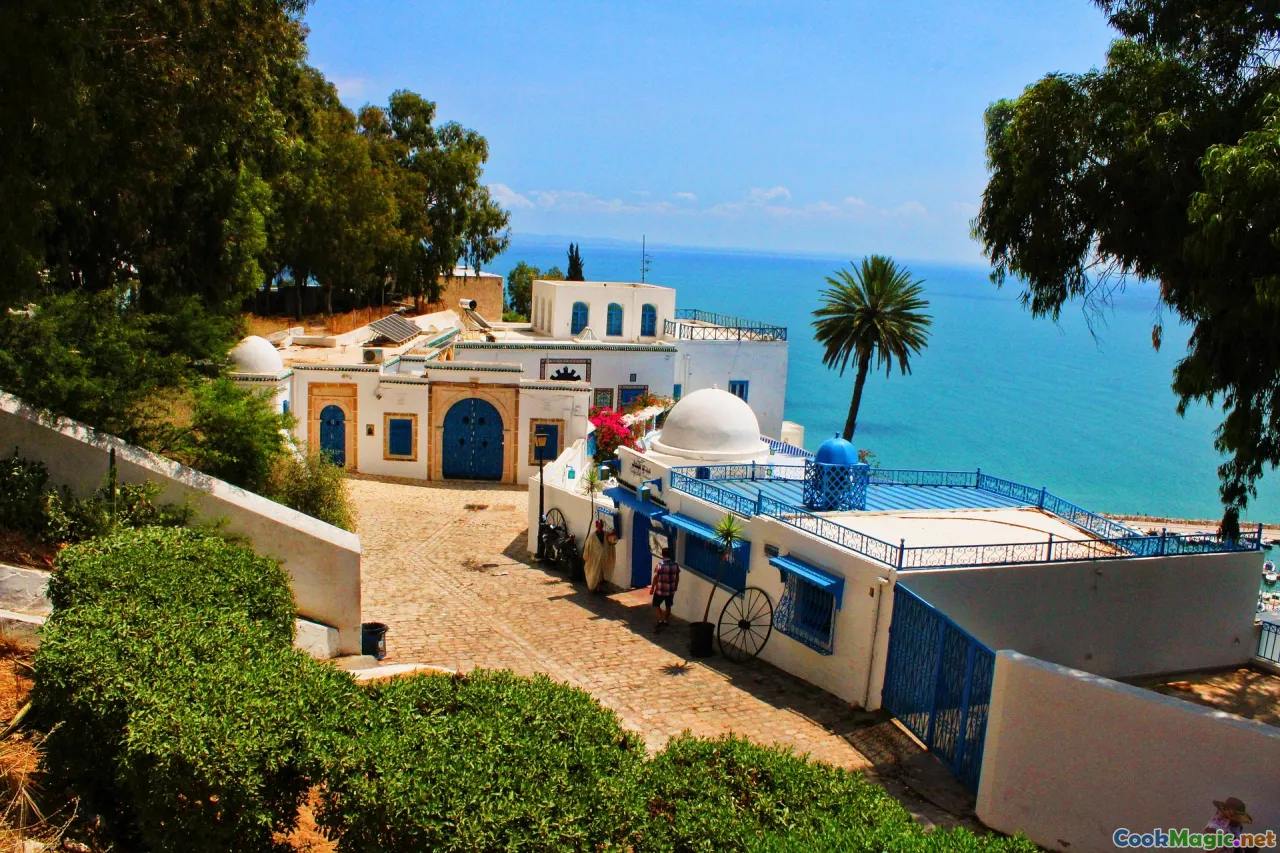
If you’re traveling and want to calibrate your home version against the benchmark, tune your appetite to these places and patterns.
- Tunis Medina: At El Ali, perched near the Zaytuna Mosque, I’ve eaten a textbook ojja bil merguez that arrives still sizzling, the yolks quivering like a promise. Their harissa is balanced, their bread rightly irreverent.
- Sidi Bou Saïd: Many cafés focus on mint tea and Bambalouni doughnuts, but ask at a neighborhood snack bar and you’ll often find ojja prepared to order—especially on market days, when peppers are at their greenest.
- Sfax: Near the fishing port, simple gargottes serve shrimp ojja that tastes like the docks: briny, garlicky, and lemoned at the end. Look for pans as old as the stoves.
- Nabeul: In Cap Bon, spice merchants know their caraway. Markets stalls sometimes offer a breakfast ojja that shows off their goods—fragrant, spicy, with a citrus edge.
Ojja is also a home dish; some of the best you’ll taste will be cooked in pans with stories. If you’re invited into a kitchen, bring fruit, praise the cook’s harissa, and ask how they know when the eggs are done. They’ll likely tap the pan’s edge and smile.
A Cook’s Timeline and Make-Ahead Strategy
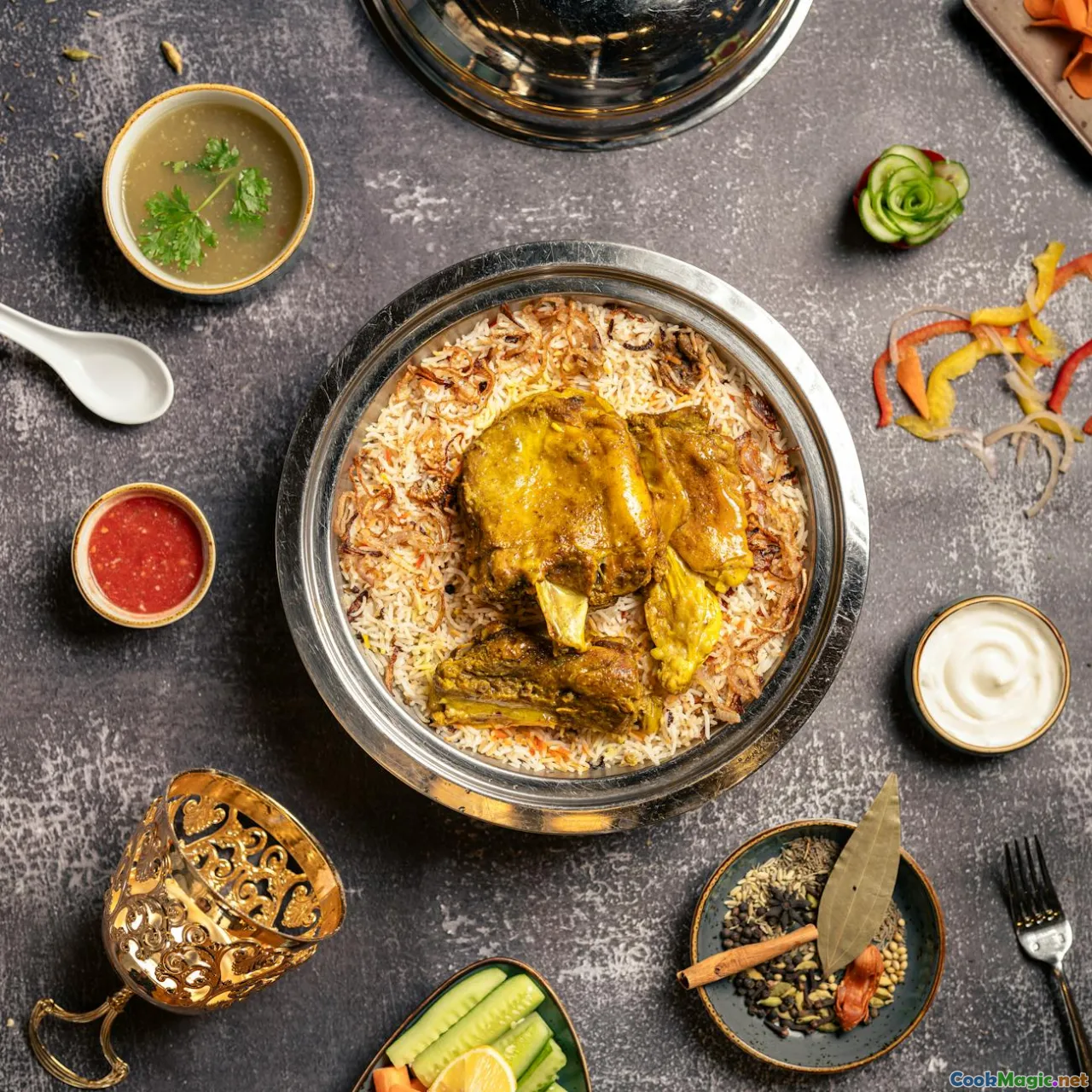
Ojja feels spontaneous, but a few preparations turn it into the fastest impressive meal you’ll make all week.
Day before or morning:
- Chop peppers and refrigerate.
- Crush garlic with salt and keep covered in a small dish of olive oil.
- Pre-blend a jar of “ojja base”: 2 tablespoons tomato paste mixed with 2 teaspoons harissa and 2 tablespoons olive oil. Keep refrigerated; it will keep a week and improves with time.
- Toast and grind caraway and coriander; store in a jar.
At go-time (15 minutes):
- Brown sausage or sear shrimp.
- Sauté peppers, stir in garlic.
- Add 2–3 teaspoons of your “ojja base,” cook until aromatic.
- Add tomatoes and simmer while you set the table and tear bread.
- Crack eggs; finish with herbs.
Leftovers strategy:
- Sauce: If you end up with extra sauce (without eggs), it’s gold. Thicken it and spread on grilled bread with a drizzle of olive oil. Or freeze in small tubs for emergency ojja.
- Next-day spin: Stir leftover sauce into beaten eggs for a quick omelet, or fold into a pan of chickpeas, finishing with lemon and parsley for a speedy lunch.
Culinary Heritage and Identity on a Plate
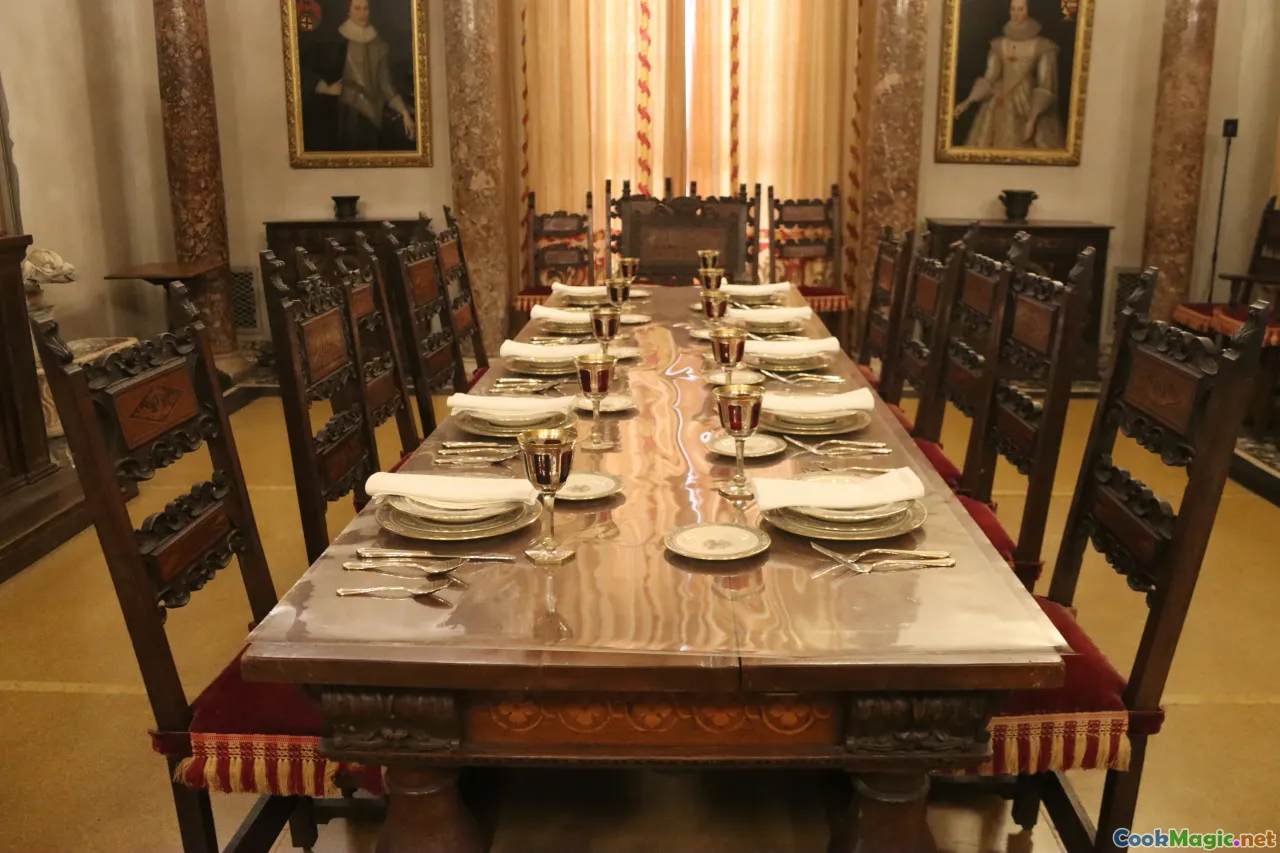
Tunisia’s culinary history is a conversation across empires and seas. Romans pressed oil here; Andalusians carried citrus and irrigation wisdom; Ottomans brought peppers; French colonization spread merguez throughout Europe. Ojja absorbs those centuries and distills them into a human-sized ritual: a pan, a flame, a few things that smell louder together than apart.
In some households, ojja is weekday food—fast, economical, comforting. In others, it’s what you make when someone you love is coming home hungry. I’ve seen a grandmother stir tomato paste with a wooden spoon worn to a crescent; I’ve watched a young cook in La Marsa swipe a fingertip of harissa and taste it like a violinist tuning a single string. Ojja, like all the best dishes, is private and public at once. You cook it to feed a craving, and you put it in the center of the table to declare, wordlessly, that we share what’s good.
Every time I lift the lid and see the yolks trembling over a red bed that smells of caraway, I feel the same tug I felt in that courtyard in Sidi Bou Saïd: the sense that something old and generous is about to be passed around. Bread tears, steam curls, someone laughs because the heat made them blink, and the pan looks already a little less full. When a dish manages to be practical and poetic, to feed a body and remind it where it belongs, it becomes more than a recipe. It becomes a way back.
Make ojja the Tunisian way—unafraid of spice, patient with paste, careful with eggs—and it will carry you into that shared space, toward the table that Tunisia has extended for centuries. If you listen closely while the sauce simmers, you’ll hear the medina waking up, even if you’re a world away.









